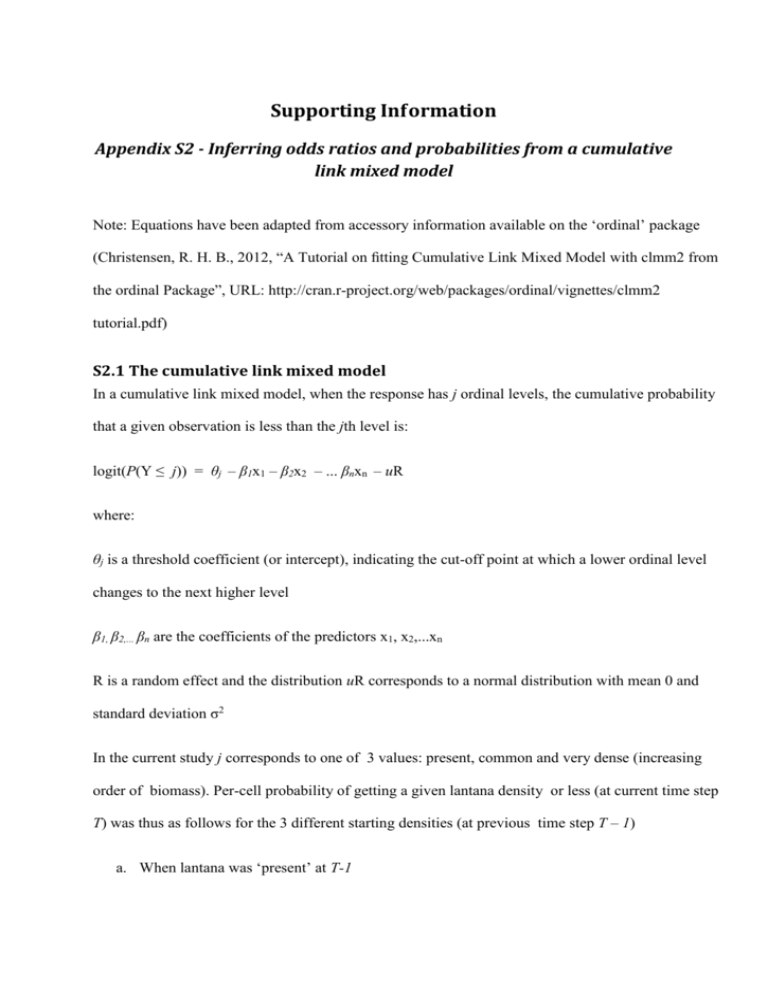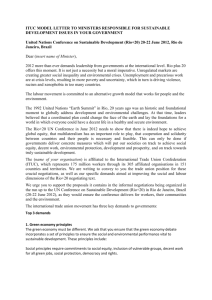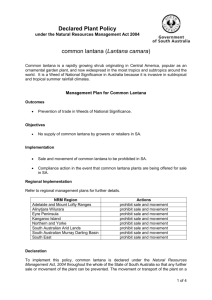Appendix S2 - Inferring odds ratios and probabilities from
advertisement

Supporting Information Appendix S2 - Inferring odds ratios and probabilities from a cumulative link mixed model Note: Equations have been adapted from accessory information available on the ‘ordinal’ package (Christensen, R. H. B., 2012, “A Tutorial on fitting Cumulative Link Mixed Model with clmm2 from the ordinal Package”, URL: http://cran.r-project.org/web/packages/ordinal/vignettes/clmm2 tutorial.pdf) S2.1 The cumulative link mixed model In a cumulative link mixed model, when the response has j ordinal levels, the cumulative probability that a given observation is less than the jth level is: logit(P(Y ≤ j)) = θj – β1x1 – β2x2 – ... βnxn – uR where: θj is a threshold coefficient (or intercept), indicating the cut-off point at which a lower ordinal level changes to the next higher level β1, β2,... βn are the coefficients of the predictors x1, x2,...xn R is a random effect and the distribution uR corresponds to a normal distribution with mean 0 and standard deviation σ2 In the current study j corresponds to one of 3 values: present, common and very dense (increasing order of biomass). Per-cell probability of getting a given lantana density or less (at current time step T) was thus as follows for the 3 different starting densities (at previous time step T – 1) a. When lantana was ‘present’ at T-1 logit(P(YT ≤ j)) = θj – (– 2.74)*L – (– 0.06)*HT-1 – 0.03*B T-1 – 0.38*R T-1 – 0.48*F T-1 – 0.6*TWI T-1 – (– 0.65)* R T-1* F T-1 – (–0.11)* R T-1*TWI T-1 b. When lantana was ‘common’ at T-1 logit(P(YT ≤ j)) = θj – (–0.09)– (– 2.74)*L – (– 0.06)*HT-1 – 0.03*B T-1 – 0.38*R T-1 – 0.48*F T-1 – 0.6*TWI T-1 – (– 0.65)* R T-1* F T-1 – (–0.11)* R T-1*TWI T-1 c. When lantana was ‘very dense’ at T-1 logit(P(YT ≤ j)) = θj – 2.32 – (– 2.74)*L – (– 0.06)*HT-1 – 0.03*B T-1 – 0.38*R T-1 – 0.48*F T-1 – 0.6*TWI – (– 0.65)* R T-1* F T-1 – (–0.11)* R T-1*TWI where: θj = threshold coefficient for transition into the jth density category at time T L = lag term (1,2 or 3) for number of gap years between two consecutive enumerations HT-1 = Helicteres isora stem density at time T-1 B T-1 = Basal area of trees at time T-1 R T-1 = Annual rainfall received at time T-1; average rainfall if L > 1 F T-1 = cumulative number of fire events (0,1,2 or 3) between T and T-1; F T-1 > 1 only when L > 2 TWI = topographic wetness index of the cell For examining the effects of a single predictor, all others were held at a mean (scaled) value of zero. When an interaction was explored, all predictors except those interacting were set to zero. In this paper, only results from eqn. a. have been reported. S2.2 Calculating the odds ratio The odds ratio for getting an observation that is ≥ j for a treatment (categorical variable) is given as exp(βtreatment). In this study, the only categorical variable is lantana density in the previous time step. The βs for Lantana (Common) and Lantana (Very Dense) in Table 2 (-0.09 and 2.32 respectively) give the log odds of getting a lower lantana density v/s a higher lantana density in the current time step, when the cell was occupied by ‘common’ and ‘very dense’ categories relative to the ‘present’ category of lantana in the previous time step. Thus the odds ratio for getting a lower (present or common) v/s higher density (common or very dense) of lantana in the current time step when lantana was ‘common’ relative to the ‘present’ category in the previous time step = exp(-0.09) = 0.92 but at lantana ‘very dense’ relative to the ‘present’ category, the odds ratio is: exp(2.32) = 10.17 S2.3 Calculating the probability of getting a single density level Probabilities for different density categories for a given predictor ‘x’ and time lag ‘L’ were calculated as follows: P(‘present’) = logit-1(θpresent to common – βx – βlagL) P(‘common’) = logit-1(θcommon to very dense – βx – βlagL) – logit-1(θpresent to common – βx – βlagL) P(‘very dense’) = logit-1 (1 – (θcommon to very dense – βx – βlagL)) Such that, P(‘present’) + P(‘common’) + P(‘very dense’) = 1 Where ‘x’ is a vector of values, limited at the 95% quantile values of the scaled predictor from the observed data, while ‘L’ was held constant at 1 such that probabilities could be calculated at an average time lag of 1 year. In case of the rainfall-fire and rainfall-TWI interaction, the coefficient of the interaction term was subtracted from the threshold coefficients as well, before computing the inverse logit. The inverse logit was computed using the plogis() function in R (version 15.1).









